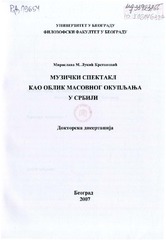Приказ основних података о документу
Музички спектакл као облик масовног окупљања у Србији
Music spectacle as a form of mass gathering in Serbia
| dc.contributor.advisor | Kovačević, Ivan | |
| dc.contributor.other | Ristović, Milan | |
| dc.contributor.other | Žikić, Bojan | |
| dc.contributor.other | Gavrilović, Ljiljana | |
| dc.creator | Lukić Krstanović, Miroslava | |
| dc.date.accessioned | 2016-01-05T12:53:34Z | |
| dc.date.accessioned | 2018-11-19T21:22:44Z | |
| dc.date.available | 2016-01-05T12:53:34Z | |
| dc.date.available | 2018-11-19T21:22:44Z | |
| dc.date.issued | 2008 | |
| dc.identifier.uri | http://eteze.bg.ac.rs/application/showtheses?thesesId=983 | |
| dc.identifier.uri | https://fedorabg.bg.ac.rs/fedora/get/o:7599/bdef:Content/download | |
| dc.identifier.uri | http://vbs.rs/scripts/cobiss?command=DISPLAY&base=70036&RID=516146327 | |
| dc.identifier.uri | http://nardus.mpn.gov.rs/123456789/3287 | |
| dc.identifier.uri | https://dais.sanu.ac.rs/123456789/4505 | |
| dc.description.abstract | Савремене комуникације, модерне визуеленe технологије, разноврсност културних садржаја, продукције и тржишта поставили су спектакле у ново поље друштвених стварности и научних интерпретација. Етнолошка и антрополошка истраживања значајно доприносе у расветљавању овог феномена. Тежиште анализе се заснива на музичким спектаклима који се највише и најбрже инфилтрирају у друштво спектакла. Они се базирају на три основне компоненте: уметност, политика и тржиште. Читање музичког спектакла упућује на позиционирање у глобалној комуникацијској мрежи, као и на његов специфичан развој и одлике у Србији у 20. веку. Аналитички дискурс подразумева да се феномен спектакла теоријски редефинише, методолошки конципира, потом, историјски реконструише, комуникацијски и семантички конструише и функционално реактивира. Анализа се заснива на истраживачком материјалу који је фокусиран на социјалистички и постсоцијалистички период у Србији. У друштвеном и историјском контексту установљене су конструкције означених – означавајућих комуникацијских образаца музичких спектакала као облика јавних и масовних окупљања: (1) модел пирамидалне хијерархије – спектакли дисциплине; (2) фронтални модел – спектакли конвенције; (3) фронтални и интерак-тивни модел – спектакли еманципације; (4) поларизован модел – херметички спектакли конфликта; (5) модел дифузије – спектакли у мрежи транзиције. Етнолошко зумирање показује да музички спектакл и свакодневица јесу у друштвеној спрези не као инверзија већ као изукрштани процеси између спектакла и свакодневног живота. Музички спектакл је рефлексија и креација свакодневног жи-вота у хипертрофираном издању и у огледалу визуелних позорница. Са тог становишта музички спектакли у историјском, културном и друштвеном контексту представљају поруке преузимајући одговорност у артикулацији друштвених стварности. | sr |
| dc.description.abstract | Contemporary communication, modern visual technologies, variety of cultural forms, productions and markets set spectacles into the new field of social realities and scientific interpretation. Ethnologic and anthropologic researches contribute greatly to the enlightening of this phenomenon. Focus of analysis is based on musical spectacles that are infiltrated in the society of spectacle. They are based on triple components: arts, politics and market. Reading of musical spectacle refers to the positioning in the global communicational net and to the specific development and characteristics in Serbia in the 20th century. Analytic discourse requires theoretic redefinition of this phenomenon, its methodological conceptualisation, historical reconstruction, communicational and semantic construction and functional reactivation. The analysis is based on the research material that is focused on the socialist and post-socialist period in Serbia. The models of spectacles – signified and signifying in certain social and historical context as a form of public and mass gatherings are: (1) construction of pyramidal hierarchy – spectacle of discipline (2) frontal construction – spectacles of convention (3) frontal and interactive construction – spectacles of emancipation (4) polarized construction – hermetic construction of conflict (5) diffusion construction – spectacles in a network of transition. Ethnological zoom reveals that music spectacle and everyday life are closely related not as an inversion, but as intertwinement processes of spectacle and every day life. Musical spectacle is reflection and creation of everyday life in the hypertrophic form and in the mirror of visual stages. According to this position musical spectacles in historical, cultural and social context are messages that overtake responsibility in the articulation of social reality. | en |
| dc.format | application/pdf | |
| dc.language | sr | |
| dc.publisher | Универзитет у Београду, Филозофски факултет | sr |
| dc.rights | openAccess | |
| dc.rights.uri | https://creativecommons.org/licenses/by-nc-nd/4.0/ | |
| dc.subject | eтнологија | sr |
| dc.subject | ethnology | en |
| dc.subject | spectacle | en |
| dc.subject | music | en |
| dc.subject | society | en |
| dc.subject | ideology | en |
| dc.subject | popular culture | en |
| dc.subject | communication | en |
| dc.subject | construction | en |
| dc.subject | music production | en |
| dc.subject | спектакл | sr |
| dc.subject | музика | sr |
| dc.subject | друштво | sr |
| dc.subject | идеологије | sr |
| dc.subject | популарна култура | sr |
| dc.subject | комуникације | sr |
| dc.subject | конструкције | sr |
| dc.subject | музичка производња | sr |
| dc.title | Музички спектакл као облик масовног окупљања у Србији | sr |
| dc.title | Music spectacle as a form of mass gathering in Serbia | en |
| dc.type | doctoralThesis | en |
| dc.rights.license | BY-NC-ND | |
| dcterms.abstract | Ковачевић, Иван; Жикић, Бојан; Гавриловић, Љиљана; Ристовић, Милан; Лукић Крстановић, Мирослава; Muzički spektakl kao oblik masovnog okupljanja u Srbiji; | |
| dc.type.version | publishedVersion | |
| dc.identifier.fulltext | https://dais.sanu.ac.rs/bitstream/id/14046/Disertacija.pdf | |
| dc.identifier.rcub | https://hdl.handle.net/21.15107/rcub_dais_4505 |

